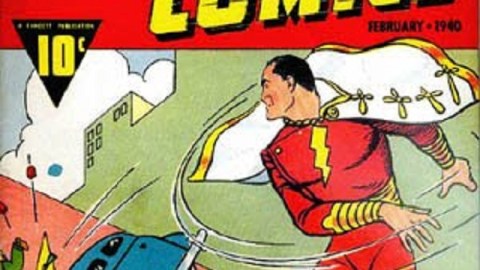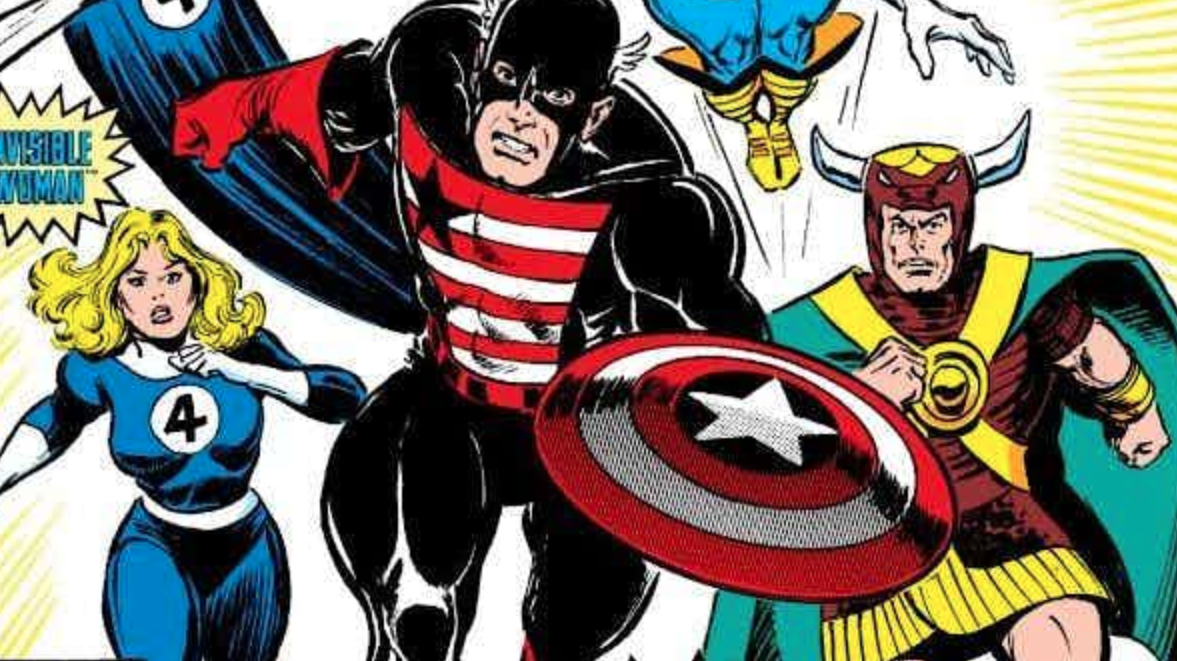Big Cheese: Remembering the Golden Age of Captain Marvel

Pretty much everyone knows that Superman is the original super hero, and maybe the greatest of that genre. As Jim Crocesang, “You don’t tug on Superman’s cape.” But one super hero did more than just tug on Big Blue’s cape. In the 1940s, Captain Marvel bested the Last Son of Krypton where it mattered most—on the newsstands. In Shazam! The Golden Age of the World’s Mightiest Mortal, Chip Kidd resurrects the days when “The Big Red Cheese,” as the Captain’s arch-villain Doctor Sivana called him, reigned supreme. It was “a phenomenon that captured the imaginations of millions, yet lasted a mere thirteen years,” Kidd writes in his narrative (colorfully illustrated by the photography of Geoff Spear) beginning with the heroics of February 1940s Whiz Comics #2 (detail above) and ending, of all places, in a courtroom. This story tells the now-forgotten rise and abrupt fall of the original big cheese of super heroes.
As anyone who’s shouted “Shazam!” should know, young Billy Batson shouts that magical word to transform into the adult Captain America. Whereas Superman and Batman tried to appeal to their young audience through young sidekicks Jimmy Olsen and Robin, Captain Marvel appealed directly to kids by making the hero’s alter ego a kid, with the added benefit of making him a daring kid reporter. C. C. Beck created the flat, simple look of the hero and writer Bill Parker provided the “aw, shucks” feel of the stories. Perhaps the greatest barometer of this powerful attraction for kids is the fact that Fawcett Comics, publishers of Captain Marvel, hired 35 to 40 employees just to handle the mail of the Captain Marvel Fan Club, which reached 400,000 members worldwide at its peak.
Building on that kid-centric approach, a whole “Marvel Family” soon arose, first with the addition of Captain Marvel Jr. (drawn by Mac Raboy) and later Mary Marvel (drawn by Marc Swayze), both of whom looked their age when foiling evil. Legend has it that a young Elvis Presley modeled his hairstyle after that of Captain Marvel Jr. (and maybe even later styled his late-period jumpsuits after the Marvel Family’s look). As Kidd explains, each member of the Marvel Family found a specific niche. “Whereas Billy [Batson]’s tales as Captain Marvel took on a grand, madcap scheme of crazed scientists, and the threat of Earth’s doom,” Kidd writes, “Freddy [Freeman’s, Captain Marvel Jr.’s alter ego,] were much more homespun and routinely involved troubled orphans, the poor, or the occasional troll being exploited by a conniving circus freak show dictator.” For Kidd, it’s this family atmosphere that really separated Captain Marvel from the pack of other heroes and helped him rise to the top.
Geoff Spear’s photographs of Captain Marvel paraphernalia helps bring the narrative alive. Rare fan club buttons and other merchandise recreate some of the hype. You can imagine a young child excitedly opening Captain Marvel’s 1944 holiday fan club letter praising paper salvage drives and War Bonds and wishing him “a Very Merry Christmas and a Victorious 1945.” Everything Marvel—from soap to Mary Marvel paper dolls to tie clips to ties to clip them to—appears here in a relentless litany of the cultural behemoth Captain Marvel once was during the peak years of comic book reading in America.
In addition to fan club perks and other merchandise, rare treats appear such as Spanish versions of the comics and even a bootleg Cuban comic of “El Capitan Maravilla.” The 1941 Republic Pictures movie serial Adventures of Captain Marvel, which came about when a Superman serial fell through, lives again in movie posters and stills featuring Tom Tyler in the title role and Frank Coghlan Jr. as Billy Batson. A complete 1941 Captain Marvel story by Joe Simon and Jack Kirby, who were working at the same time on early Captain America comics, offers a tantalizing glimpse at what could have been. Simon and Kirby recognized their workmanlike yet uninspired effort enough not to sign the story, but it remains a valuable historical conversation piece nonetheless.
It seemed that nothing could stop the Big Red Cheese until rival DC Comics, publisher of Superman, turned to the truly most powerful force on Earth—litigation. A series of lawsuits claiming that Captain Marvel simply copied Superman drained smaller Fawcett Comics’ finances over time. Although they won the first two rounds, Fawcett realized that an artist’s admission that he had indeed traced a page from a Superman comic and inserted Captain Marvel was their death knell. Fawcett settled out of court in 1953 and stopped publishing comics entirely. The heyday of American comics was over by then anyway, but Captain Marvel disappeared entirely for two decades, until, ironically, DC Comics revived the character in 1973.
Kidd, author of other comic-related books such as Bat-Manga!, Peanuts: The Art of Charles M. Schulz, and Mythology: The DC Comics Art of Alex Ross, brings a marvelous combination of scholarship, fanboy idolatry, and humor to the subject. “Batman was Menace. Superman was Power,” Kidd writes in his preface. “Captain Marvel was… Charm.” Shazam! The Golden Age of the World’s Mightiest Mortal captures the charm of the Big Red Cheese, who offered a super-powered shoulder to lean on for kids in the uncertain years of World War II and a family to join when families were forced apart. At the same time, the charm of Chip Kidd himself comes through in his realization that Captain Marvel was indeed kid stuff, but that kid stuff is important, too.
[Many thanks to Abrams Books for providing me with a review copy of Shazam! The Golden Age of the World’s Mightiest Mortal by Chip Kidd, with photographs by Geoff Spear.]





